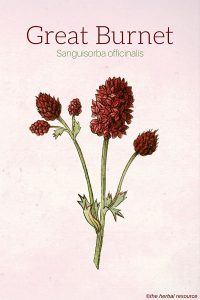The main substances found in great burnet are flavonoids, saponins, ursolic acid, arabinose, essential oil, vitamin C, and tannins.
The scientific name Sanguisorba refers to the herbs medicinal properties where “anguis” means blood and “sorb” means “to suck up”.
For centuries the plant has mostly been used as a hemostatic agent both in Western and Chinese herbal medicine.
The rhizomes of great burnet contain a high amount of tannins (up to 17% ) which are responsible for the astringent, antiseptic and anti-inflammatory properties of the herb.
In both Chinese and Western herbal medicine a decoction of the root has been used internally for heavy menstrual bleeding, blood in stool and urine, bleeding hemorrhoids and uterine bleeding.
Because of the astringent and anti-inflammatory action of the plant it has been utilized in the treatment of a variety of digestive disorders, such as diarrhea, dysentery, enteritis, ulcerative colitis, irritable bowel syndrome and irritable colon.
Great burnet has demonstrated in vitro an inhibitory effect on many pathogenic bacteria such as Staphylococcus aureus, Streptococcus pneumoniae and Pseudomonas aeruginosa.
A mouthwash can be made from the herb and used as an herbal treatment for gum inflammation and swollen tonsils.
Great burnet has been used externally as a folk remedy for nose bleed, wounds, burns, eczema, rash, boils and hemorrhoids.
The young leaves and shoots have a nice taste and can be eaten raw or used in salad. For this use, the plant should be harvested before it blooms.
[Read more about Great Burnet…]

Leave a Reply